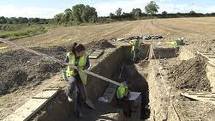
The Midlands Viking Symposium begins in Dublin tomorrow and one of the more interesting talks being presented is by Eamonn P. Kelly (National Museum of Ireland), in which he discusses the results of a recent archaeological excavation carried out at Annagassan, Co. Louth.
Annagassan, or Linn Duchaill, is the site of one of the most important early longphorts in Ireland. A longphort is a defended Viking encampment that was used as a base for raiding the surrounding countryside. Its name is derived from the Irish words long=boat and phort=fort, i.e. a shipfort. Annagassan is first mentioned in the Annals in 841 AD, the same year that Dublin was founded, and for a period it appears to have rivalled the future capital city in importance. In 842 the Annagassan Vikings plundered the large monastery at Clonmacnoise and also captured the abbot of Clogher, while in 852 they devastated Armagh. However, in 891 their luck finally ran out and they were expelled by the local Irish. They did return briefly two decades later but by 927 the camp appears to have been abandoned. Thus for over fifty years Annagassan was one of the most important Viking bases in Ireland. Indeed, it may have even have approached the size of a small trading town, which specialised in exporting slaves and looted goods.
The exact site of this significant longphort has long been speculated about but it wasn’t until this excavation, carried out under the direction of Dr. Mark Clinton, that its location, size and extent were for the first time accurately defined. The excavation was carried out in the summer of 2010 and its final results are eagerly awaited. It was a fine example of collaborative archaeology, where the local community, under the auspices of the Annagassan & District Historical Society, was fully involved. School groups were also encouraged to visit the site, while funding for the excavation was supplied by the Louth Leadership partnership, along with additional support from Dundalk County Museum and the Louth Archaeological and Historical Society.
The site investigated was located on a bend in the river Dee near its confluence with the Irish Sea, an area that would have allowed Viking Longboats to be moored securely. The location was naturally well defended as it was surrounded on three sides by the river Dee, leaving only one approach route for attackers. The excavation revealed that to counter this, the Vikings of Annagassan had excavated a large and substantial ditch, which effectively cut off the peninsula formed by the bend in the river. Within this large defensive enclosure evidence for postholes and metalled surfaces were found suggesting the remains of buildings, while a variety of artefacts were recovered included hack silver (fragments of cut silver items for reuse), pins, spindle whorls, ship nails and butchered animal bone.
The results of this his exciting excavation will be discussed in detail at tomorrow’s lecture along with a number of other Viking related topics. Should be a very interesting conference.
Links
Midlands Viking Symposium programme


